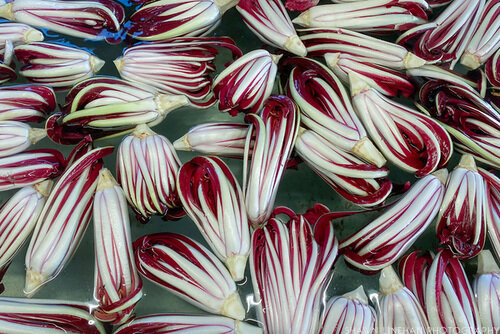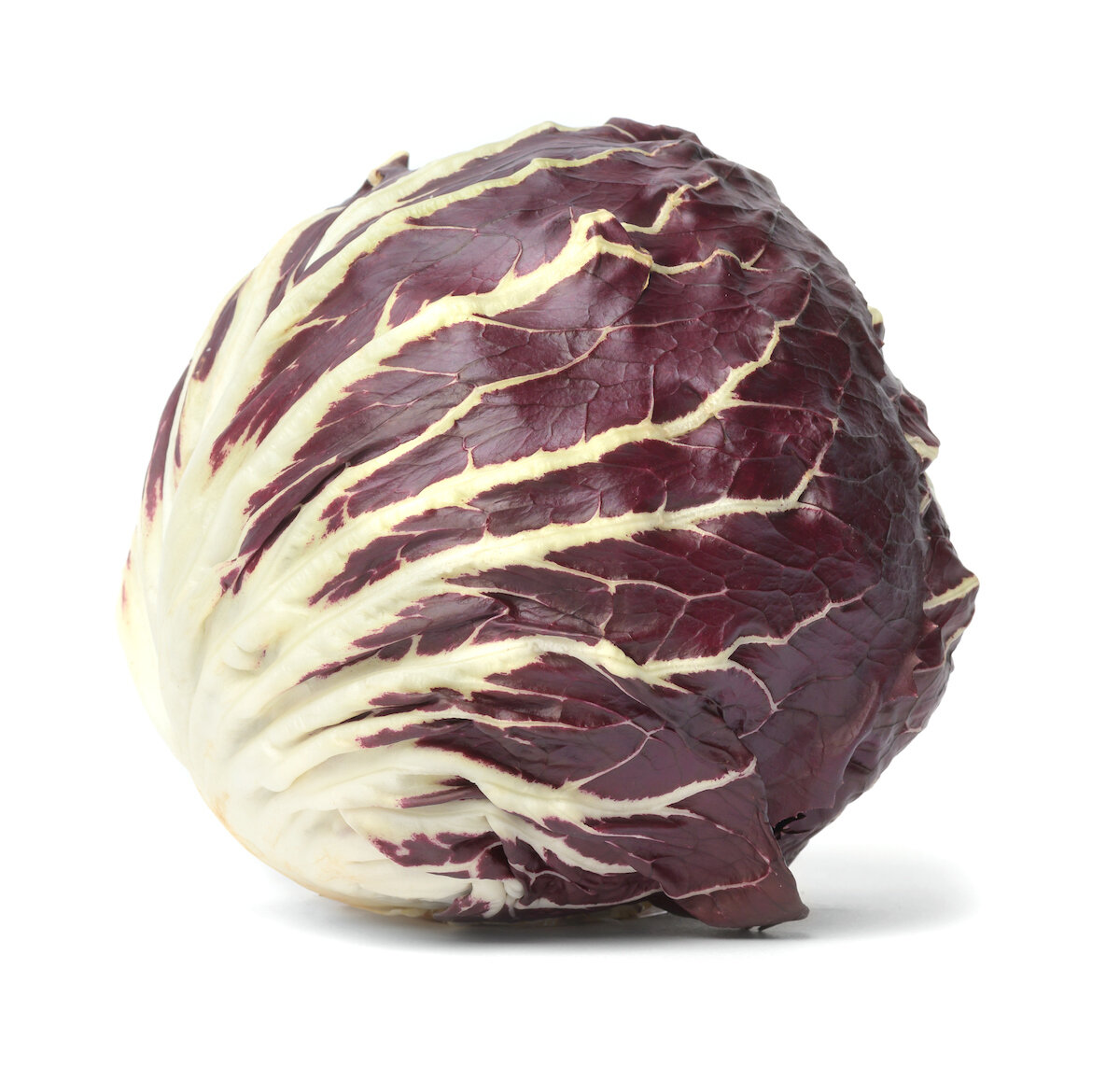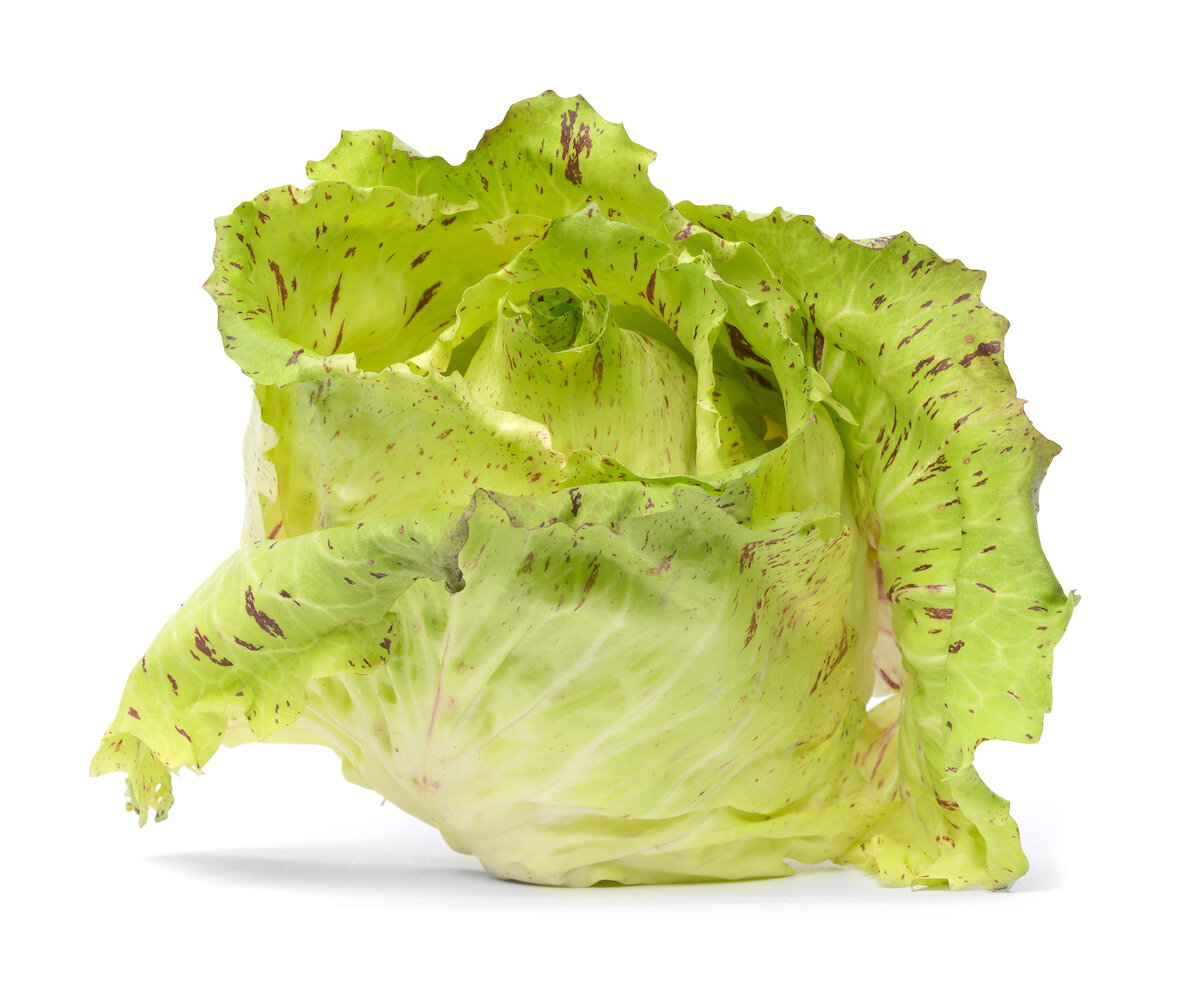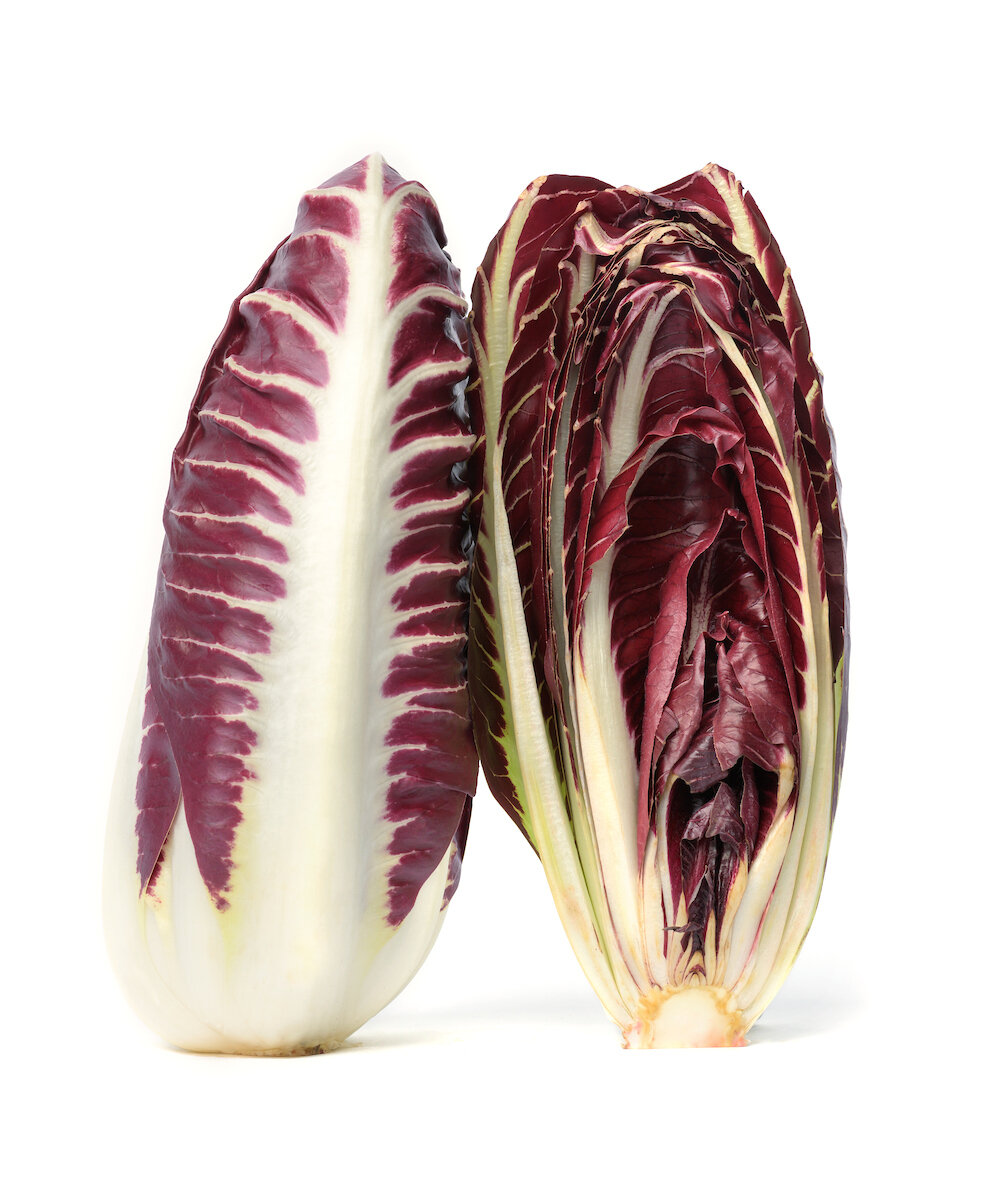Types of Radicchio
Radicchio has lots of names, and switching between “Chicory” and “Radicchio” gets confusing. So… here’s the deal:
CHICORY
It all starts with wild chicory, a plant that people have been harvesting and eating for millennia. Wild chicory comes in a variety of shapes and colors, but it basically looks like dandelion. This humble weed is the ancestor to every type of chicory and radicchio we know today. It can be found all over the world, where it thrives in field edges and along roadsides. Wild ‘cicoria selvatica’ is still eaten widely in many regions of Italy. Chicory, in the US, is a term used to refer to all vegetables in the Chicorium genus, including radicchio, but also frisée, escarole, Belgian endive, and “dandelion” greens (also known as Catalogna chicory). In Italy, ‘cicoria’ (chicory) refers specifically to dark green, loose-leaf types, either cultivated or wild. Most often these are braised, but sometimes picked small/young and used as salad.
RADICCHIO
At its most basic, Radicchio is the name used to refer to types of chicory that form a tight head. The refined varieties of radicchio we know today were likely selected originally by propagating particularly red specimens of wild chicory. Mass selection and intentional cross-breeding resulted in the types that are most widely grown at this time. Just as Romaine, Bibb, and Leaf lettuce are all “lettuce”, so too are Rosso di Treviso and Castelfranco both types of radicchio. Within each type, there are many different named varieties which plant breeders continue to introduce as improved versions of the classical phenotypes. For example, named varieties of Castelfranco include ‘Lucrezia,’ and ‘Fenice’ from T&T seeds in the Veneto, and ‘Kulla’s Castelfranco’ from Wild Garden Seeds in Oregon.
Click on a photo of the types below for more information.
Rosso di Treviso Tardivo is the primogenitor of all cultivated varieties of radicchio; the variety of radicchio that started it all. Emerging from local selections of wild chicories back in the 15th century, Treviso Tardivo was grown to be eaten in the dead of winter, when other fresh vegetables had long since died. Tardivo (‘late’ in Italian) is a variety of radicchio that is harvested, leaves and root both, in the late-fall, stored in a root cellar, and ‘forced’ in darkness to turn the leaves a darker shade of red, and whiten the midrib.
When the plants are done being forced, they most closely resemble a huge ball of slime. While the new inner leaves are growing, the outer leaves are rotting. The transformation that occurs when you clean Treviso Tardivo is nothing short of magical. The slimy, outer layers are peeled away. The muddy, knobby root is trimmed back to a cream colored trapezoidal nub. A stunning head of radicchio emerges. Resembling a squid more than anything else, the red leaves are long and slender, curling at the tips like the head of a violin. The midrib is bright white, thick, and very crunchy. Treviso Tardivo is by far the most elegant radicchio there is.
Treviso Tardivo are also the mildest and crunchiest of all the varieties of radicchio. Recipes often call for them to be cooked or grilled, but in our opinion, what makes Tardivo special is its mild crunchiness. Tardivo, for this reason, is best served raw, with the lightest oil and salt dressing.
Rosso di Chioggia radicchio, often (mistakenly) referred to as simply Radicchio, or Palla Rossa (red ball), are the most commonly known and widely grown type of radicchio in the world. Arriving on the scene relatively recently, these are the type of radicchio you are most likely to find on the shelves of your local grocery store.
Chioggia radicchio are dense, red balls with a relatively thin crunchy leaf that is streaked with white veins. Unlike its red cousins from Treviso and Verona, the ribs and veins on Chioggia are more integrated into the leaf, essentially having the same taste and texture. Often mistaken for cabbage, Chioggia radicchio are anything but. Crunchy, bitter, piquant, and beautiful, Chioggia radicchio are wonderful eaten grilled as well as chopped raw into a salad. Chioggia radicchio are less bitter than Rosso di Verona, but more bitter than Treviso or any of the Green/Yellow varieties.
Rosa del Veneto is a radicchio very similar in appearance to Rosso di Verona, but bright pink in color, instead of red. The name is a sort of Italian pun/homonym. ‘Rosa’ means both Rose and Pink, and the heads are definitely pink and often shaped like a rose. These amazing radicchio are relative newcomers to the pantheon of Radicchio, apparently discovered in a field of Rosso di Verona, and selected and re-selected to accentuate the pink color.
Rosa del Veneto are less refined than their red cousin, being younger and still, apparently, moving through the awkward tween years. Many heads of Rosa del Veneto are shaped like a squashed football, like Rosso di Verona. Others, have a more open architecture, layers of overlapping leaves open to the sky, more so resembling a rose than a football.
These stunning pink heads are perhaps the most bitter variety of radicchio out there, but because their pink color fades when cooked, Rosa del Veneto are definitely best served raw.
If Treviso Tardivo is the King of Radicchio, Castelfranco is the queen. Called ‘The Tulip of Winter’ because of its distinct tulip-like shape, variegated Castelfranco is most refined and elegant. There is an old story in the Veneto of a noblewoman from Castelfranco attending a wintertime premier at the Teatro alla Scala in Milan who adorned her gown with a head of Castelfranco radicchio. Everyone believed it was an exotic flower imported from far away.
Castelfranco radicchio have a beautiful tulip-like shape, with an open architecture that resembles a lettuce. The leaves are thin, yet crisp. Like Variegato di Lusia, they start out green with red flecks and become buttery yellow with more red flecks as you move towards the heart. The flavor is mild for a chicory, but still with some lovely radicchio bitterness.
Rosso di Verona, as a distinct cultivar, is believed to have emerged in the mid- to late-18th century in the farming areas around the city of Verona. Improved breeding techniques in the late-18th and early 19th centuries helped shape the variety to become what it is today, and there is evidence that farmers first started bringing it market, rather than just growing them for personal use, by the early 19th century. As with most varieties of radicchio that were grown back then, Rosso di Verona were grown out during the summer, harvested with their roots on, and stored in root cellars for forcing through the winter. Amazingly, when farmers forced Rosso di Verona, they buried their stored plants in holes dug into composting manure piles. The heat from the composting manure triggered the plants to put on new growth, and the darkness accentuated the red color of the leaves and whitened the mid-rib. There isn’t any specific evidence regarding the effect burying the heads in manure had on flavor.
Rosso di Verona could be described as the ‘cutest’ of all the varieties of radicchio. Shaped like a squashed football, heads of Rosso di Verona are a deep crimson-red, with a thick, crunchy white mid-rib. The leaves are a somewhat triangular and cup shaped, perfect for filling with a delicious spread. Rosso di Verona radicchio are on the more bitter end of the bitterness spectrum, though as with all radicchio, they get sweeter as the weather gets colder in late-fall and early-winter.
Treviso Precoce (precoce means early) is the upstart younger sibling to Treviso Tardivo. Whereas, Tardivo requires the ‘imbianchiamento’ blanching to achieve its final form, Treviso Precoce does not need to be stored in darkness to develop its deep red leaves and thick, white mid-rib. Treviso Precoce forms a dense, football shaped head in the field. The heads have wine-red leaves and a thick, crunchy white center rib.
Of all the red varieties of radicchio, Treviso Precoce is among the least bitter, second only to Treviso Tardivo. After going through a few frosts, some might even describe the leaves as bitter-sweet. The leaf part retaining bitter characteristics, but the rib developing a pleasant sweetness that offsets the bitter compounds in the leaf.





